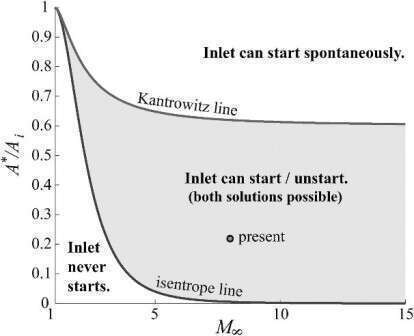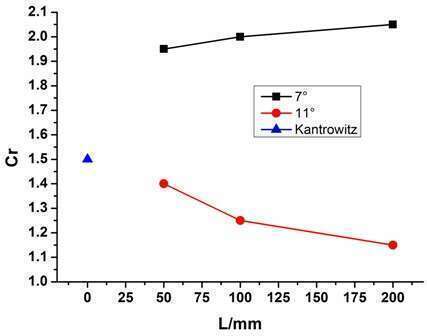The inlet is a crucial opponent of hypersonic airbreathing engines, which should decelerate and compress the airflow with minimum losses. For efficient engine operation the inlet must be started, while many factors can cause the inlet unstart, which can conclude to two main reasons: low cowl Mach number and high backpressure [1]. As the inlet unstarts, the thrust of engine decreases rapidly, and efficient methods must be taken to assure the inlet can restart. For a fixed geometry inlet, which is widely used in industry, the restart capability plays a vital role in inlet restarting. However, the process of inlet unstart/restart, involving complex effect of shock wave/boundary layer interaction, is one of the most challenging problems of hypersonic gas-dynamics, and numerous studies have been performed to study the inlet self-starting capability.
Based on quasisteady inviscid one-dimensional-flow assumptions, Kantrowitz firstly prescribed the axisymmetric inlet self-starting capability with respect of the inflow Mach number M∞ and area contraction ratio Ai/A*.[2,3] Figure 1 shows three domains divided by two curves, the inlet can always start spontaneously above the kantrowitz line and never start below the isentropic line, while a dual solution area exists between the Kantrowitz line and isentropic line, where the inlet can either start or unstart. The Kantrowitz theory provides a basic criterion for inlet design, but its assumption usually differs with the real condition and many experiments have verified the inlet can start beyond Kantrowitz limit and the theory is not applicable.Van Wie classified the inlet unstart profile into two broad categories as either “hard” or “soft” according to a series of experiments. [4] The hard unstart/restart, resulted by the choke at the throat, was consistent with the Kantrowitz theory; while the soft unstart/restart occurred as large scale separation bubble existed in the inlet, and the Kantrowitz theory became invalid. Goldberg also experimentally studied the effect of boundary layer thickness on the inlet self-starting capability. [5] He took the total pressure recovery as the key parameter whether an inlet can restart, and results also showed that the ratio of cowl height h and boundary layer thickness δ was less than 2, the total pressure recovery became sensible, even small perturbation caused inlet unstart. On the other hand, the effect of boundary layer wasn’t obvious when h/δ was more than 2. In fact, the researches foreign and domestic are centered on the unstart/restart profile as well as the factor of the inlet self-starting, but no universal results can prescribe the inlet self-starting capability due to different inlet geometry and coupled factors effect. So singer-factor experiment on simple inlet model to investigate self-starting capability is necessity.
In this paper, a method of diaphragm rupture controlled by igniter to simulate inlet unstart/restart process, is used to investigate the self-starting characteristics in shock tunnel, as shown in Figure 2. Based on simplified inlet models (figure 3), various experiments have been conducted to investigate the effect of cowl shock wave as well as boundary layer relative thickness on the performance of the flow field. Results show that the cowl shock wave strength determines the inlet starting capability, the inlet self-starting internal contraction ratio (ICR) decreases fast with a stronger cowl shock wave (Figure 4). While the interaction of boundary layer and cowl shock wave, induces larger separation bubble with an increase of boundary layer relative thickness, and the inlet starting internal contraction ratio decreases rapidly. It is remarkable that when L is quite short, the inlet self-starting internal contraction ratio tends to Kantrowitz limit (Figure 5), the reason for that is the unstart shock oscillates away from the leading edge of the boundary layer with a short L, and it is more like a normal shock, swallowing into the throat after diaphragm rupture, which is consistent with the Kantrowitz assumption.

Figure 1 Possible flow regimes in supersonic/hypersonic inlets
Figure 2 Device for inlet self-starting experiment
1 Shock tunnel nozzle 2 Pressure probe 3 Delay time signal generator 4 Electrical igniter 5 Hypersonic inlet 6 Device for diaphragm installation 7 Terylene diaphragm
Figure 3 inlets model
Figure 4 Inlet self-starting limit ICR with different cowl shock strength

Figure 5 inlets self-starting limit ICR with different L
Reference
[1] Evgeny V. Timofeev and Rabi B. Tahir, “On recent developments related to flow starting in hypersonic air intakes,” AIAA 2008-2512.
[2] Kantrowitz, A., and Donaldson, C., “Preliminary Investigation of Supersonic Diffusers,” NACA ACR-L5D20, May 1945.
[3] Kantrowitz, A., “The Formation and Stability of Normal Shock Waves in Channel Flows,” NACATN 1225, March 1947.
[4] Van Wie, Kwok and Walsh, “Starting characteristics of supersonic inlets,” AIAA 1996-2914
[5] Tbeodore J. Goldberg, Jerry N. Hefner, “Starting Phenomena for Hypersonic Inlet with Thick Turbulent Boundary Layers at Mach 6,” NASA TN D-6280.

